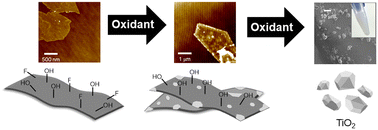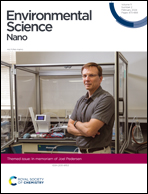Stability of Ti3C2Tx MXenes in engineered environments†
Abstract
MXenes are a newer class of 2D materials with desirable properties, making them attractive for various environmental applications, including remediation and as membranes for water treatment. Until recently, the practical implementation of MXenes was hindered by their instability in water, although improved synthesis procedures have addressed this issue. Consequently, it is now important to assess the stability of MXenes in engineered environments relevant to drinking water and membrane operation (e.g. backwashing). In this study, Ti3C2Tx MXenes were found to remain stable upon exposure to an aqueous environment saturated with oxygen and to UVC and UVA light at circumneutral pH, but were transformed upon exposure to excess free chlorine and to Fe(III) chloride at a concentration equal to 5 mg L−1 free chlorine. The chlorination reaction kinetics are 1st order with respect to Ti3C2Tx and free chlorine concentration from 20 to 200 mg L−1. The rate constant increased at pH ≤7.5, implicating HOCl as the reactive species. We propose that MXene reactions with HOCl occur by an electrophilic attack of Cl+, forming TiO2 and degrading the MXene. AFM data show that transformations are initiated at the edges of the MXene sheets and localized areas on the MXene, suggesting that the initial sites for Cl+ attack are defect sites and/or uncoordinated Ti atoms. This contrasts with the inertness of nanoscale TiC, highlighting the need to devise surface modification processes that will allow MXenes to resist the oxidative conditions associated with membrane regeneration/backwashing.

- This article is part of the themed collection: Environmental Science: Nano Recent HOT Articles


 Please wait while we load your content...
Please wait while we load your content...